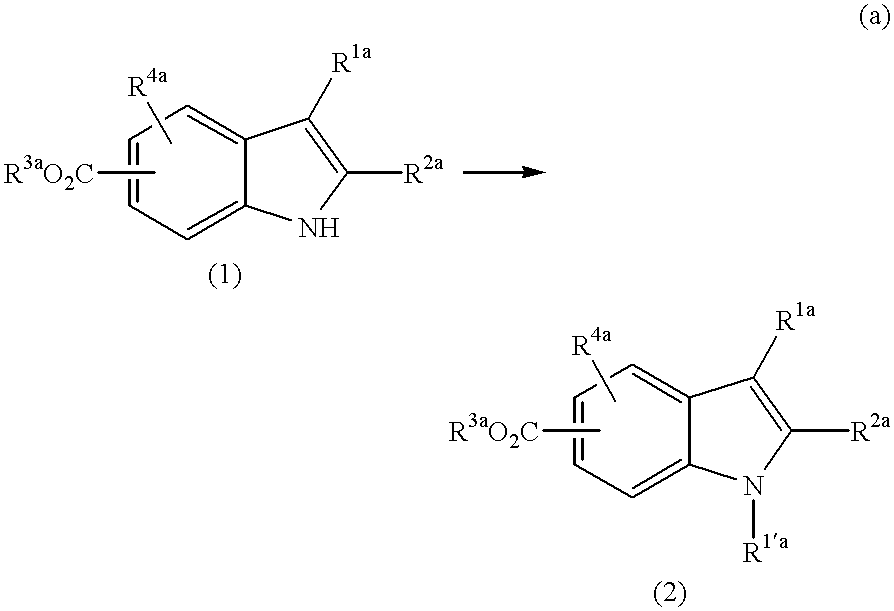Method for inhibiting neoplastic cells with indole derivatives
a technology of indole and neoplastic cells, which is applied in the field of inhibiting neoplastic cells with indole derivatives, can solve the problems of increasing the risk of colon cancer in japan, little progress in the prevention and treatment of colorectal cancer, and the discovery of most of these cancers too late for surgical cur
- Summary
- Abstract
- Description
- Claims
- Application Information
AI Technical Summary
Problems solved by technology
Method used
Image
Examples
production example 2
6-Methoxycarbonyl-2-Methylindole
A mixed solution of methyl 4-(2-oxopropyl)-3-nitrobenzoate (3.86 g), reduced iron (9.0 g) and acetic acid (40 ml) is stirred at 90.degree. C. for 24 hours. The solid is removed through filtration, and the filtrate is concentrated under reduced pressure. The resulting residue is purified through silica gel column chromatography (eluent: hexane / ethyl acetate=3 / 1) to obtain 6-methoxycarbonyl-2-methylindole (0.890 g).
[Physical Properties of the Product]
.sup.1 H-NMR (CDCl.sub.3, .delta.): 2.46 (3H, s), 3.90 (3H, s), 6.25 (1H, s), 7.48 (1H, d, J=8.3 Hz), 7.72 (1H, dd, J=1.4 Hz and 8.3 Hz), 7.97 (1H, s), 8.39 (1H, brs).
example 1
Production of 1-(2-chlorobenzyl)-6-methoxycarbonyl-2-methylindole (30)
A mixture of 6-methoxycarbonyl-2-methylindole (0.89 g), 2-chlorobenzyl bromide (1.45 g), potassium carbonate (0.780 g) and N,N-dimethylformamide (2 ml) is stirred at 80.degree. C. for 18 hours. The solvent is evaporated away under reduced pressure, and the resulting residue is purified through silica gel column chromatography (eluent: hexane / chloroform=3 / 1) to obtain 1-(2-chlorobenzyl)-6-methoxycarbonyl-2-methylindole (30) (0.660 g).
[Physical Properties of Compound (30)]
.sup.1 H-NMR (CDCl.sub.3, .delta.): 2.35 (3H, s), 3.88 (3H, s), 5.41 (2H, s), 6.17 (1H, d, J=7.8 Hz), 6.42 (1H, s), 7.02 (1H, t, J=7.6 Hz), 7.18 (1H, t, J=7.1 Hz), 7.42 (1H, d, J=8.0 Hz), 7.58 (1H, d, J=8.3 Hz), 7.80 (1H, dd, J=1.2 and 8.3 Hz).
example 2
Production of 6-carboxy-1-(2-chlorobenzyl)-2-methylindole (31)
A mixture of 1-(2-chlorobenzyl)-6-methoxycarbonyl-2-methylindole (0.630 g), aqueous 10% sodium hydroxide solution (2.7 g), water (1.8 g) and ethanol (7.0 g) is refluxed for 2.5 hours. After cooled, this is processed with 10% HCl to have a pH of 4, and the crystal formed is taken out through filtration and dried to obtain 6-carboxy-1-(2-chlorobenzyl)-2-methylindole (31) (0.480 g).
[Physical Properties of Compound (31)]
.sup.1 H-NMR (DMSO-d6, .delta.): 2.35 (3H, s), 5.53 (2H, s), 6.13 (1H, d, J=7.6 Hz), 6.46 (1H, s), 7.15 (1H, t, J=7.6 Hz), 7.28 (1H, t, J=7.6 Hz), 7.54 (2H, t, J=8.3 Hz), 7.62 (1H, d, J=8.3 Hz), 12.49 (1H, brs).
PUM
 Login to View More
Login to View More Abstract
Description
Claims
Application Information
 Login to View More
Login to View More - R&D
- Intellectual Property
- Life Sciences
- Materials
- Tech Scout
- Unparalleled Data Quality
- Higher Quality Content
- 60% Fewer Hallucinations
Browse by: Latest US Patents, China's latest patents, Technical Efficacy Thesaurus, Application Domain, Technology Topic, Popular Technical Reports.
© 2025 PatSnap. All rights reserved.Legal|Privacy policy|Modern Slavery Act Transparency Statement|Sitemap|About US| Contact US: help@patsnap.com



